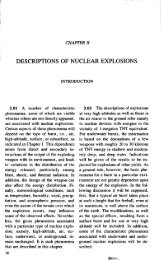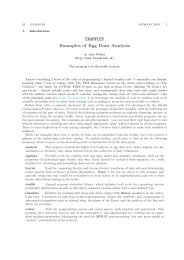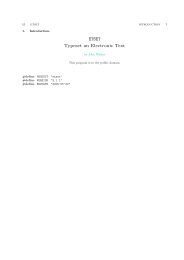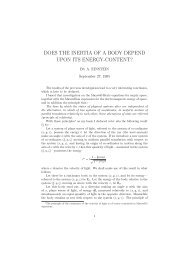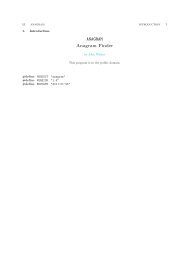The Annoyance Filter.pdf - Fourmilab
The Annoyance Filter.pdf - Fourmilab
The Annoyance Filter.pdf - Fourmilab
Create successful ePaper yourself
Turn your PDF publications into a flip-book with our unique Google optimized e-Paper software.
§9 ANNOYANCE-FILTER A BRIEF HISTORY OF ANNOYANCE-FILTER 15<br />
9. A Brief History of annoyance-filter.<br />
In a real sense, this program has been twenty-five years in the making. <strong>The</strong> seed was planted in the 1970’s<br />
while thinking about Jim Warren’s concept of ”datacasting”. He envisioned using subcarriers of FM stations<br />
(or perhaps data encoded in the vertical retrace interval of television signals) to transmit digital information<br />
freely accessible to all. Not Xanadu or the Internet, mind you . . . this remained a one-to-many broadcast<br />
medium, but one capable of providing information in a form which the then-emerging personal computers<br />
could receive, digest, and present in a customised fashion to their users.<br />
“But who pays?” Well, that detail, which played a large part in the inflation and demise of the recent<br />
.com bubble, was central to the feasibility of datacasting as well. Jim Warren’s view was that the primarily<br />
advertiser-supported business model adopted by most U.S. print and broadcast media would be equally<br />
applicable to bits flung into the ether from a radio antenna. As I recall, he cited the experience of suburban<br />
weekly newspapers, which discovered their profits increased when they moved from a paid subscription/percopy<br />
readership to free distribution—circulation went up, advertising rates rose apace, and the bottom line<br />
changed from red to green.<br />
Intriguing . . . but still I had my doubts. When you read a newspaper or magazine, you can’t avoid the<br />
advertising—you can flip past it, to be sure, but you still have to look at it, at least momentarily, so there’s<br />
always the possibility a sufficiently clever image or tag line may motivate you to read the rest. I asked Jim<br />
why, once a document was in an entirely digital form, folks couldn’t develop filters to remove the advertising<br />
before it ever reached their eyes. This would destroy the free distribution model and render an advertisingsupported<br />
digital broadcasting service unworkable. Jim wasn’t too concerned about this. In his estimation,<br />
discriminating advertising from editorial content would require artificial intelligence which did not exist and<br />
wasn’t remotely on the horizon.<br />
That’s when von Mises’ words on advertising came back to me. Advertising is advertising—perforce,<br />
it speaks with a different vocabulary than the sports page, letters to the editor, police blotter, national<br />
and international news, and commentary (aside, perhaps, from Maureen Dowd’s columns in <strong>The</strong> New York<br />
Times). Given a sufficiently large collection of known editorial copy and advertising, might it not be possible<br />
to extract a signature, in the sense of radar signatures to discriminate warheads from decoys in ballistic<br />
missile defence, with which a sufficiently clever program could identify advertising and remove it, with a<br />
high level of confidence, before the reader ever saw it?<br />
Fast forward—or, more precisely, pause. . . . By the late 1970’s I’d concluded the best strategy to make the<br />
most of the ambient malaise was to amass a huge pile of money. Money may not buy happiness, but at the<br />
very least it would mitigate many of the irritations of that bleak, collectivist era. Being a nerd, I immediately<br />
turned to technology for a quick fix, and what should I espy but an exploding market in affordable home video<br />
cassette recorders—-VCRs—which were, in those days, becoming a fixture in more and more households.<br />
Many VCRs were purchased to play rented movies, but, being also able to automatically record programs<br />
off-the-air on a preset schedule, they could be used for “time-shifting”—recording broadcast programs for<br />
later viewing. But why, thought I, sit though all those tedious commercials you’ve recorded along with the<br />
programs you intend to watch? Certainly, people quickly learned to “zip”—use the fast forward to skip past<br />
commercials—but what if you could detect commercials and “zap” them—never record them in the first<br />
place? It occurred to me that inventing a device which accomplished this might be lucrative indeed.<br />
<strong>The</strong> concept couldn’t have been simpler—a little box which monitors the video and audio of the channel<br />
you’re recording and, based on real-time analysis of the signal, pauses and resumes recording of the program<br />
on your VCR, yielding a tape free of advertising. It was easy to imagine such a gizmo succeeding like the<br />
contemporary “Demon Dialer” telephone speed dialer add-on, selling in the tens of millions in a matter of<br />
months. 2 Imagine the dismay of advertisers and my own contented avarice as I watched the money bin fill<br />
2 Well of course it occurred to me that widespread adoption of such a device would motivate advertisers to<br />
disguise the tags that discriminated commercials from programs. But hey—by the time that happened I’d<br />
have already cashed the customers’ checks and blown the joint. <strong>The</strong>re was bit of the Ferengi in me then.<br />
Truth be told, there still is.





